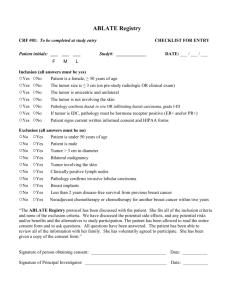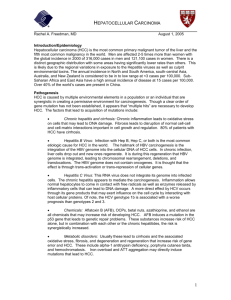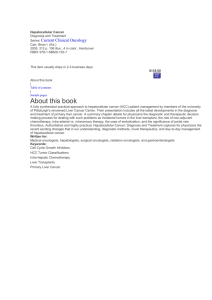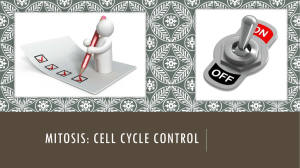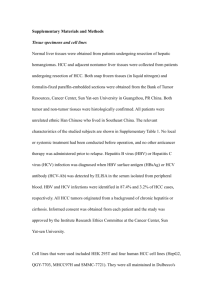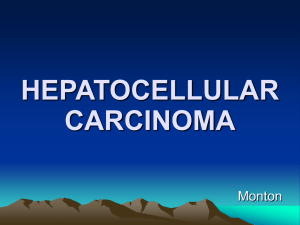Figures - BioMed Central
advertisement
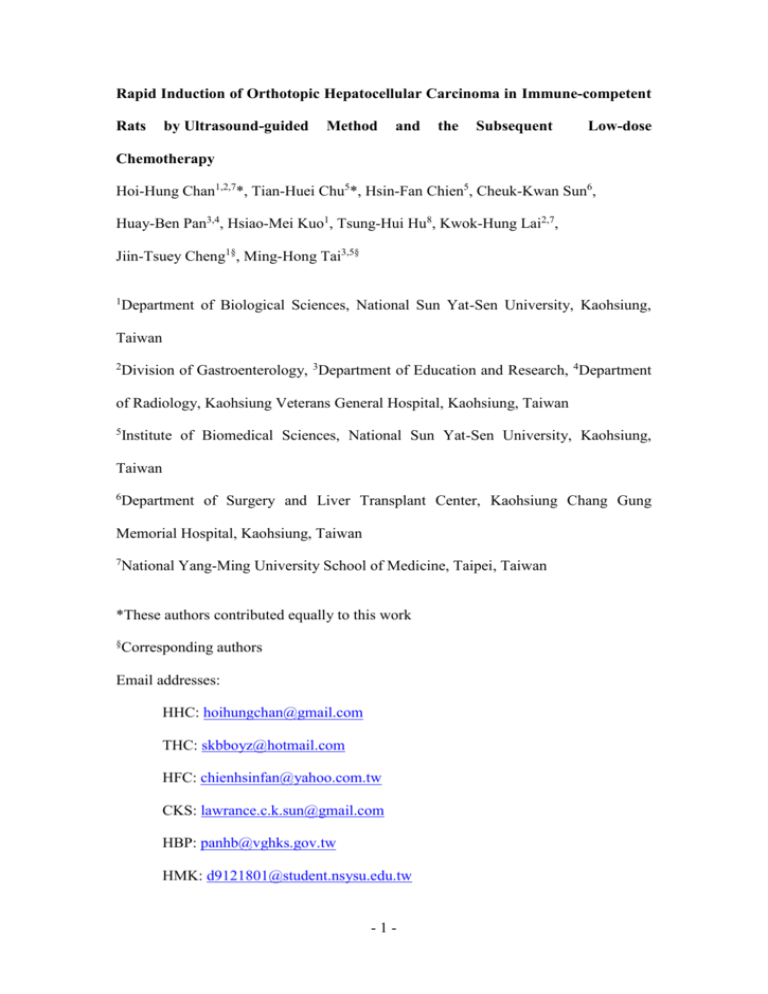
Rapid Induction of Orthotopic Hepatocellular Carcinoma in Immune-competent Rats by Ultrasound-guided Method and the Subsequent Low-dose Chemotherapy Hoi-Hung Chan1,2,7*, Tian-Huei Chu5*, Hsin-Fan Chien5, Cheuk-Kwan Sun6, Huay-Ben Pan3,4, Hsiao-Mei Kuo1, Tsung-Hui Hu8, Kwok-Hung Lai2,7, Jiin-Tsuey Cheng1§, Ming-Hong Tai3,5§ 1 Department of Biological Sciences, National Sun Yat-Sen University, Kaohsiung, Taiwan 2 Division of Gastroenterology, 3Department of Education and Research, 4Department of Radiology, Kaohsiung Veterans General Hospital, Kaohsiung, Taiwan 5 Institute of Biomedical Sciences, National Sun Yat-Sen University, Kaohsiung, Taiwan 6 Department of Surgery and Liver Transplant Center, Kaohsiung Chang Gung Memorial Hospital, Kaohsiung, Taiwan 7 National Yang-Ming University School of Medicine, Taipei, Taiwan *These authors contributed equally to this work § Corresponding authors Email addresses: HHC: hoihungchan@gmail.com THC: skbboyz@hotmail.com HFC: chienhsinfan@yahoo.com.tw CKS: lawrance.c.k.sun@gmail.com HBP: panhb@vghks.gov.tw HMK: d9121801@student.nsysu.edu.tw -1- THH: dr.hu@msa.hinet.net KHL: khlai@vghks.gov.tw JTC: tusya@mail.nsysu.edu.tw MHT: minghongtai@gmail.com -2- Abstract Background Prognosis remains poor in patients with advanced hepatocellular carcinoma, underscoring the demand of suitable animal models to speed up the development of anti-cancer drugs. The current study has undertaken a relatively non-invasive approach to induce an orthotopic hepatocellular carcinoma model in immunecompetent rats by ultrasound-guided implantation of the cancer cells and has employed this model to evaluate the therapeutic efficacy of short-term (7-day), lowdose epirubicin chemotherapy. Methods Rat Novikoff hepatoma cells were injected percutaneously into the liver lobes of Sprague-Dawley rats under the guidance of high resolution ultrasound. The implantation rate and the correlation between dissected and ultrasound-measured tumor sizes were evaluated. Similar induction procedure was repeated by means of laparotomy in a different group of rats. Pairs of tumor measurement were compared by ultrasound and computerized tomography scan. Rats with the successful establishment of the tumor were divided into the short-term (7-day), low-dose epirubicin chemotherapy (treatment) and control groups, and tumor sizes were noninvasively monitored by the same ultrasound machine. Blood and tumor tissues from tumor-bearing rats were examined by biochemical and histological analysis, respectively. Results Ultrasound-guided implantation of Novikoff hepatoma cells led to the formation of orthotopic hepatocellular carcinoma in 60.4% (55/91) of the Sprague-Dawley rats. -3- Besides, tumor sizes measured by ultrasound were significantly correlated with those measured by calipers after sacrificing the animals (P < 0.00001). The rate of tumor induction by ultrasound was comparable with that by laparotomy (55/91, 60.4% vs. 39/52, 75%) and no significant difference in sizes of tumor formation was found between the two groups. There was a significant correlation in tumor size measurement by ultrasound and computerized tomography scan. In tumor-bearing rats, short-term, low-dose epirubicin chemotherapy caused a significant reduction of tumor growth and was found to be associated with enhanced apoptosis and attenuated proliferation as well as a decrease in the microvessel density in tumors. Conclusion Ultrasound-guided implantation of Novikoff hepatoma cells represents an effective approach to establish the orthotopic hepatocellular carcinoma in Sprague-Dawley rats. Short-term, low-dose epirubicin chemotherapy has perturbed the tumor progression by inducing apoptosis and neovascularization blockade. -4- Background Hepatocellular carcinoma (HCC) constitutes the most common pathological type (7085%) of primary liver cancers. Besides, it is one of the most frequent malignancies worldwide, particularly in Asia and Africa. The incidence is still rising in some countries such as Central Europe, North America and Oceania with unknown reason [1]. Unfortunately, most of the HCC patients have non-specific symptoms [2] and would possibly miss the chance of receiving curative treatment. Ultrasound (with or without contrast agents) is sensitive in detecting the small HCC while new generation computerized tomography (CT) includes spiral and triphasic scanners can improve the specificity in differentiating HCC from other kinds of liver cancers. Serum αfetoprotein (AFP) is probably the most frequently used tumor marker for the diagnosis of HCC. But, the sensitivity and specificity of AFP needs further means of reinforcement such as exploring the subtypes of it. Routine use of percutaneous needle biopsy of HCC is controversial and better reserved for situation when definite histological diagnosis is mandatory [3,4]. Nowadays, tumor resection as well as liver transplantation is the mainstay of curative therapies for HCC. However, only 10-15% of newly diagnosed patients in Asia have the resectable disease. Local therapies such as radiofrequency ablation and alcohol injection are alternatives for small tumor and patients unsuitable for surgical intervention with results in high success rates. Transarterial chemoembolisation (TACE) is recommended for selected cases of locally advanced large unresectable tumors with good liver function reserve and no vascular involvement [5]. Prognosis is dismal for advanced or metastatic tumors [6]. Therefore; the development of a suitable model for tests of new treatment modalities for HCC is -5- urgently required. Screening of drug candidates for HCC is usually performed using xenografted HCC in immune-deficient mice such as nude or severe combined immunodeficiency (SCID) mice. In such xenografted models, tumors are relatively vulnerable because they are not grown in vascularized livers. In addition, such studies fail to delineate the efficacy of therapeutic agents in animals with intact immune systems. In order to develop intervention strategies for HCC, it is essential to create an immune-competent animal model bearing tumor in the liver (orthotopic HCC). To create animal models with orthotopic HCC, laparotomy implantation of hepatoma cells into syngeneic or immune-deficient animals has been employed in previous studies [7,8]. However, it is rather time-consuming and traumatic that experimental animals often suffer from adverse events such as bleeding, infection and tumor adhesion to the tissues and organs. Conditions are even more complicated when repeated monitoring of the tumor status is needed. Percutaneous therapies such as radiofrequency ablation with the guidance of real-time Ultrasound (US) have been widely used for the treatment of HCC resulting in high efficacy and safety [9]. An US machine can also be used as a tool for tumor implantation and measuring the subsequent changes of the created tumors [8]. However, due to the small size of rat livers compared with those of humans, it is a prerequisite to have a high resolution US machine as well as a high frequency probe for precise tumor measurement and USguided injection. In the current study, we therefore investigated the feasibility and efficacy of creating orthotopic HCC (transplantable liver cancer) in a rodent model by US-guided implantation. We employed Novikoff hepatoma (N1-S1) cells, which were derived from Sprague-Dawley (SD) rats administered with N-2-fluorenylphthalamic acid (FPA), for US-guided implantation into the liver lobes of SD rats. -6- Epirubicin, similar to doxorubicin as a derivative of anthracycline , can inhibit topoiosomerase II-α (TOP2A) enzyme with a result in preventing the cleavage of supercoiled DNA and blocking DNA transcription and replication. It has been used alone [10] or in combination with other anticancer agents [11,12] in the treatment of advanced HCC. Studies have shown that regimens contain epirubicin or doxorubicin causing similar response rates and overall median survival. However, epirubicin is less myelotoxic and cardiotoxic than doxorubicin [13]. Metronomic dosing, a new concept of chemotherapy described by Browder et al., [14] and Klement et al., [15] by using low-dose of cytotoxic drugs, either by the continuous infusion or frequent administration without extended rest periods in the treatment of malignancy. It is less toxic and better accepted by patients than the traditional maximum tolerated dose (MTD) of chemotherapy. It also has the additional benefit of targeting the tumor endothelium instead of tumor cells resulting in an anti-angiogenic effect [ 16]. In the current study, we first evaluated the feasibility of using US-guided implantation of N1-S1 cells to generate orthotopic HCC in rats and the reliability of using the same machine to monitor the tumor progression within the rats. Subsequently, rats bearing established HCC were treated with short-term (7-day), low-dose epirubicin chemotherapy. We aimed in evaluating the therapeutic efficacy of this modality and the related mechanism of the treatment in this novel HCC model. Methods Cell cultures -7- Rat Novikoff hepatoma (N1-S1) cells were cultured in the RPMI 1640 medium (Life Technologies, Rockville, MD) containing 100 U/mL penicillin (Hyclone, Bio-Check Laboratories Ltd., USA), 100 μg/mL streptomycin (Hyclone, Bio-Check Laboratories Ltd., USA), 5% fetal calf serum (GIBCO BRL, Rockville, MD) and 2 mmol/L glutamine (Hyclone, Bio-Check Laboratories Ltd., USA) under humidified conditions in 95% air and 5% CO2 at 37oC. A normal rat hepatocyte cell line (Clone-9) derived from normal SpragueDawley rat liver was purchased from Bioresource Collection and Research Center (BCRC) no. 60201, Hsin-Chu, Taiwan. Animal studies All experimental procedures were reviewed and approved by the Institutional Animal Care and Use Committee before the study began, and we ensured that all animals received humane care and that study protocols complied with the institution's guidelines. Male Sprague-Dawley (SD; 150 ± 50 g) rats purchased from the National Animal Center (Taipei, Taiwan) were used in this study. Guidelines for pain experiments on conscious animals were adhered to throughout the experiments. The animals were housed two per cage, in [beta]-chip lined metal cages in a central animal care facility with a 12-hour light and 12-hour dark cycle. They were fed with rat chow and water ad libitum. After anesthetization, N1-S1 cells (5 x 106 cells suspended in 100 µl of RPMI1640) were injected percutaneously into the liver parenchyma of the SD rats using a 29-gauge syringe under the guidance of real-time US with a high frequency linear array transducer operating at 7-14 MHz (GE Logiq 9® Ultrasound -8- System). Similar induction procedure was repeated by means of laparotomy in a different group of rats. Ten days after induction, animals were anesthetized and tumor sizes were measured by US in two perpendicular diameters and expressed as the mean of the two measurements [8]. Subsequently, rats were sacrificed and the HCC sizes were measured by calipers. Plasma samples were collected from tumor-bearing rats and subjected to biochemical analysis including glutamic oxaloacetic transaminase (GOT) and glutamic pyruvic transaminase (GPT) levels using an automatic biochemical analyzer (DAX96, Bayer Corp. Diagnostic, Milan, Italy). Fifteen pairs of tumor measurement were done by US and functional (perfusion) computerized tomography (CT) scan as previously described by Kan Z [ 17] while the results of the two types of measurements were plotted and compared by Pearson’s correlation. Short-term (7-day), low-dose epirubicin chemotherapy for treatment of HCC in SD rats To those animals with successful implantation of orthotopic HCC in the 10th day, twenty-two SD rats with comparable sizes of tumor were divided into the treatment (n =11) and control (n =11) groups. Low-dose epirubicin at 0.3mg/day/rat x 7 days (the risk of congestive heart failure might have achieved at cumulative doses greater than 900 mg m-2 (about 20mg kg-1) [ 18, 19]) was injected through the rats' tail vein in the treatment group. After completion of treatment, tumor sizes measured by US were compared between groups and with those before treatment. Moreover, real tumor sizes were obtained after sacrifice by caliper measurement as well as tumor weights. Peripheral blood was drawn from the tail veins of the rats after completion of the treatment for checking the white and red blood cells as well as the platelet counts. -9- Western Blot analyses The protein extracts were isolated using RIPA buffer (150 mM NaCl, 50 mM HEPES pH 7, 1% Triton X-100, 10% glycerol, 1.5 mM MgCl2, 1 mM EGTA) containing a protease inhibitor (Roche Applied Science; Indianapolis, IN). After separation in 12.5% SDS-PAGE, protein samples were transferred onto polyvinylidene fluoride (PVDF) membrane using blotting apparatus. The membrane was blocked with 5 % milk in TBS-T for 1 h. Then, it was incubated with TOP2A antibody (1:500, cellsignaling) for 1 h at room temperature. After incubation with HRP-conjugated secondary antibody (1:5000 dilutions in 5 % milk) for 60 minutes, the signals on membrane were detected using ECL-plus luminol solution (Pharmacia; Piscataway, NJ) and exposed to X-ray film for autoradiogram. Immunohistochemistry analysis The paraffin-embedded tissue blocks were sectioned into 3-millimeter slices and mounted on poly-L-lysine-coated slides. After deparaffinization, the slides were blocked with 3% hydrogen peroxide for 10 minutes and subjected to antigen retrieval by microwave in 10 mM citrate buffer for 15 minutes. TOP2A (1:50, cell-signaling), Ki-67 antibodies (1:100 dilution, Dako, Denmark) and PECAM-1 (platelet endothelial cell adhesion molecule-1), CD31 (1:50 dilution; Santa Cruz Biotechnology Inc.), PECAM-1 (platelet endothelial cell adhesion molecule-1, 1:50 dilution; Santa Cruz Biotechnology Inc.), were applied onto the sections and incubated at room temperature for 60 minutes followed by repeated washing with phosphate-buffered saline (PBS). Horseradish peroxidase/Fab polymer conjugate (Polymer Detection System, Zymed, USA) was then applied to the sections and the sections were incubated for 30 minutes. After rinsing with PBS, the sections were incubated with peroxidase substrate diaminobenzidine (1:20 dilution, Zymed) for 5 minutes. - 10 - Thereafter, the sections were counterstained with Gill's hematoxylin for 20 seconds, dehydrated with serial ethyl alcohol, cleared with xylene, and finally mounted. For comparison, results of the percentage of Ki-67-positive staining were counted under low power fields while PECAM-1was presented as the amount of positive staining under high power fields. The terminal deoxynucleotidyl transferase-mediated dUTP nick end-labeling (TUNEL) staining The TUNEL assay was used to detect DNA fragmentation. Briefly, the hepatoma sections on slides were deparaffinized, and then washed with PBS. TUNEL analysis was performed using the in situ Cell Death Detection Kit Fluorescein (Roche Molecular Biochemicals; Indianapolis, IN) according to the manufacturer's protocol. TUNEL-positive cells were visualized by immunofluorescent microscopy and counted using a 20× objective. TUNEL-positive cells containing FITC were identified by co-localization with 4,6-diamidino-2-phenylindole (DAPI) staining and by morphology. More than 100 cells were counted for each variable per experiment. The slides were viewed under a fluorescence microscope with green fluorescence set at 520 nm. The cells stained green indicated apoptotic cells. For comparison, the amount of positive staining was counted under low power fields. Statistics The induction rate of HCC by the US-guided method was presented as the percentage of rats with successful tumor induction divided by the total number of rats enrolled. The tumor sizes were expressed as mean ± standard deviation. Pearson’s correlation - 11 - was applied to compare the results of US and the corresponding measurements. Continuous variables were compared with the Student’s t test. A P < 0.05 on twotailed testing was considered significant. Results Ultrasound-guided implantation of N1-S1 cells effectively induced orthotopic HCC in SD rats To generate orthotopic HCC in immune-competent rats, N1-S1 cells were implanted into the liver lobes of the anesthetized SD rats under the guidance by high resolution - 12 - US on day 1 (Figure 1a). After 10 days, US revealed prominent HCC in 60.4% (55/91) of animals with an average size of 16.23 mm (Figure 1b). The presence of HCC was further confirmed after sacrificing animals for caliper measurement (Figure 1c). The rate of tumor induction by US was comparable with that by laparotomy (55/91, 60.4% vs. 39/52, 75%) and no significant difference in sizes of tumor formation was found between the two groups (Number of rats: US vs. laparotomy: 55 vs. 39, P= 0.6759, Figure 1d). Indeed, it took much less time to perform ultrasound implantation. Besides, the animals recovered better and were free of adhesive tumor nodules at injection sites. Therefore, the ultrasound-guided implantation of N1-S1 cells into liver lobes constituted an effective approach to induce orthotopic HCC in SD rats. The ultrasound-measured HCC size was highly correlated with the caliper measurement, plasma GOT level, and CT-measured tumor size To evaluate the accuracy of US measurement, we first compared the US-measured HCC sizes with the caliper measurement after rats were immediately sacrificed. The HCC sizes measured by US (16.23 ± 12.58 mm; n = 55) were similar to that by caliper measurement (18.63 ± 12.95 mm; n = 55). Moreover, there was an excellent correlation between US-measured and caliper-measured HCC sizes (Pearson’s correlation coefficient = 0.8697, n = 55, *** P < 0 .0001, Figure 2a), indicating the fidelity of US for HCC monitoring in the animal study. The biochemical parameters in blood samples from HCC-bearing rats were determined to investigate the relationship between US-measured HCC sizes and plasma GOT/GPT levels. Interestingly, the US-measured HCC sizes were - 13 - significantly correlated with plasma GOT level (Pearson’s correlation coefficient = 0.6484, n = 71, *** P < 0.0001; Figure 2b), but not with GPT (data not shown). As CT scan was a fast and reliable approach to acquire two-dimensional tumor images, a portion of HCC-bearing rats was subjected to CT scan examination immediately after US diagnosis. There was a significant correlation in tumor size measurement by US and CT scan (Pearson’s correlation coefficient = 0.687, n = 15, * P < 0.05; Figures 2c and 2d). However, no direct significant correlation was obtained between the perfusion data and microvessel density changes presented in Figure 6c. On the other hand, similar results in comparing the tumor sizes were obtained in terms of tumor volumes (US vs. caliper: n=55, correlation coefficient= 0.7988, ***P <0.0001; US vs. CT: n= 15, correlation coefficient= 0.9099, ***P < 0.0001). Together, these findings strongly supported the fidelity of US-based monitoring of HCC progression in rats. Short-term, low-dose epirubicin chemotherapy led to stable disease in rats bearing established HCC Subsequently, rats bearing established HCC were subjected to short-term (7-day), low-dose epirubicin therapy to validate the utility of this animal model for drug screening (Figure 3a). When tumors were successfully established on day 10, the animals were divided into two groups treated with vehicle and epirubicin therapy respectively. After completion of treatment, ultrasound monitoring revealed that the tumor burden in vehicle-treated HCC continued to increase (**P < 0.01; Figure 3b) whereas the tumors in rats treated with epirubicin therapy showed no significant increment (P = 0.1737). After sacrificing the animals, it was found that the tumor - 14 - sizes of the control group were significantly larger than that of the epirubicin group (* P < 0.05; Figure 3c) while the tumor weight exhibited a similar trend but without significance (P = 0.0906; Figure 3d). On the other hand, epirubicin treatment caused significant bone marrow suppression relative to the control group in terms of pancytopenia (Figures 4a, 4b and 4c). Short-term, low-dose epirubicin chemotherapy induced apoptosis and neovascularization blockade in HCC Abundant TOP2A enzyme expressions in N1-S1 cells were shown by both Western blot tests (protein extracts from cancer cells vs. the normal hepatocyte, Clone 9, Figure 5a) and in tumor specimens by immunohistochemistry studies (tumor vs. nontumor parts, Figures 5b, 5c and 5d). To investigate the tumor-suppressing mechanism underlying epirubicin therapy, HCC samples were subjected to various histological analysis. TUNEL staining revealed significant increase in apoptotic cells in epirubicin-treated tumors as compared with the control group (Figure 6a). On the other hand, there was a significant reduction of Ki67-positive, proliferating cells in the epirubicin-treated HCC (Figure 6b). Interestingly, the number of PECAM-1- positive blood vessels was also decreased in epirubicin-treated HCC (Figure 6c). Therefore, short-term, low-dose epirubicin chemotherapy has perturbed HCC proliferation through apoptosis induction as well as angiogenesis inhibition. Discussion To our knowledge, the current study has demonstrated the potential of ultrasoundguided implantation for the first time to create orthotopic HCC in immune-competent rodent. Compared with other HCC models (include laparotomy), it possesses the - 15 - advantages of easy manipulation (it took less than two hours to accomplish the implantation procedure in twenty animals), minimal trauma to the experimental animals, highly reproducible, early disease onset (tumor can be detected by US within 10 days after implantation), and the feasibility to evaluate the effects of drug therapy on the tumors. Moreover, tumor measurement by US is highly accurate, which has been approved by functional CT scan as well as real sizes after sacrificing the animals. There are only a few options for the treatment of advanced HCC. Besides, it lacks standard regimens of chemotherapy for this dismal cancer. Many chemotherapeutic agents have been tested in HCC, with response rates ranging between 10% and 15%, but no survival advantage has been demonstrated [ 20]. This may be due to the unbearable side effects of the conventional maximum tolerated dose (MTD) of chemotherapy upon patients who already have chronic liver diseases and cirrhosis, and limited effects due to genetic variations amount the cancer cells resulting in diversity of drug sensitivity [ 21]. In addition, tumor organization further diminishes the drug effect by the development of multi-cellular drug resistance [ 22]. On the other hand, the method of low dose, either through continuous infusion or frequent administration of chemotherapeutic drugs without extended rest periods (metronomic chemotherapy), is believed to attack the tumor vessels instead of tumor parenchyma [14,15]. It has been demonstrated that this anti-angiogenic property can facilitate the cytotoxic effects of chemotherapeutic agents on the cancer cells [ 23-25]. This regimen can theoretically improve the tolerance of the patients and prolong the treatment period and enhance the therapeutic efficacy of the cytotoxic drugs on the tumor cells. - 16 - Evidence from both basal and clinical researches has demonstrated the therapeutic effects of metronomic chemotherapy on certain kinds of solid tumors such as ovarian [ 26] and breast cancers. Colleoni et al. [ 27] have shown in their clinical trial that low-dose metronomic cyclophosphamide plus methotrexate is efficacious in the treatment of metastatic breast cancer with additional benefits of low cost and prolongation of the treatment period. However, similar reports on the treatment of HCC are rarely found in the literature. TOP2A over-expression seems to be correlating with the aggressiveness of HCC in terms of early age onset, advanced histological grading, microvascular invasion, chemoresistence, tumor recurrence and mortality [28,29]. This implicates the potential therapeutic value of epirubicin in targeting TOP2A in the management of HCC. Besides, epirubicin is one of the most frequently used chemotherapeutic agents in the treatment of HCC, either alone or in combination with other cytotoxic drugs, through various methods include TACE (transcatheter chemoembolization), systemic chemotherapy and trans-catheter arterial infusion chemotherapy [ 30-36]. Although the present study is only a short-term investigation that failed to elucidate the long-term therapeutic impact of epirubicin on HCC in an orthotopic animal model, several findings are noteworthy. Firstly, we found over-expression of TOP2A in N1-S1 HCC both in the protein and histology levels. Secondly, we found significant effect of the current regimen of epirubicin chemotherapy on HCC growth in this brief animal trial despite the association of bone marrow suppression. Thirdly, the short-term, low-dose epirubicin had high therapeutic potential in terms of histological changes of HCC. It significantly suppressed the proliferation of HCC cells as shown by the Ki-67 staining in comparing with the control group. In addition, - 17 - TUNEL test revealed an increase in the extent of apoptosis of HCC by the action of chemotherapy. Furthermore, and perhaps most importantly, the angiogenesis of the tumor endothelium decreased in the treatment group. However, the optimal dose of metronomic chemotherapy, either as chemopreventive or therapeutic, remained to be elusive [ 37]. In addition, our orthotopic HCC animal model was not without shortcomings such as lack of concurrent chronic liver diseases or cirrhosis that could not completely represent the reality in human condition. Furthermore, Tang et al., [38] recently reported an orthotopic advanced HCC model in which significant improved overall survival was observed using various combinations of metronomic chemotherapy regimens with targeted antiangiogenic drugs. This is quite impressive and encouraging. They used laparotomy method to create the orthotopic HCC in SCID mice and then monitored the changes in tumor sizes by using a novel non-invasive approach (transplantation of tumor cells that have been transfected with the β-hCG gene). Both that study and our present study have successfully established valuable orthotopic HCC models that can be followed noninvasively either using a gene tranfection method or sonographically. Our method has the additional advantage of being close to the clinical situation in which ultrasound is the major tool for following tumor progression. Also, both studies have demonstrated the great potential of low-dose chemotherapy, either used alone or in combination with antiangiogenic agents, in the treatment of HCC. Conclusion In this study, encouraging results have been obtained that ultrasound-guided tumor implantation of N1-S1 cells has led to the growth of orthotopic HCC in about 60% of SD rats, which is comparable to the method of laparotomy. It is a fairly effective and - 18 - feasible method for establishing an animal model of HCC for future therapeutic trials. It greatly reduces the time period expected for the tumor response to the experimental drugs. Moreover, we have shown the therapeutic efficacies of low-dose epirubicin on HCC growth in terms of tumor size, cancer cell proliferation, apoptosis as well as angiogenesis. On the other hand, the optimal dose of metronomic epirubicin should be substantiated by modifications of the current orthotopic animal model and running clinical trials in the future. Competing interests The authors declare that they have no competing interests. Authors' contributions HHC, MHT, JTC, HBP and KHL designed the study and analyzed the data. HHC, THH and MHT were responsible for writing the manuscript and revising it critically for important intellectual content. CKS performed the animal experiment. HHC, THC HFC, and HMK performed the animal study, Western blot and pathological experiments. Acknowledgements This study was funded in part by grants from Kaohsiung Veterans General Hospital, Taiwan (VGHKS97G-11, Dr. Chan), the National Science Council, Taiwan (NSC-952320-B-075B-003-MY3), Chang Gung Memorial Hospital, Taiwan (CMRPG, Sun CK), and National Sun Yat-Sen University-Kaohsiung Medical University Joint Research Center, Taiwan. The authors thank Miss Yee-Man Chan for checking of English grammar. - 19 - References 1. El-Serag HB. Hepatocellular carcinoma: an epidemiologic view. J Clin Gastroenterol 2002, 35:S72-S78. 2. Franco T, Paola E, Gian L, et al. Clinical and pathologic features of hepatocellular carcinoma in young and older Italian patients. Cancer 1996, 71:2223-2232. 3. Befeler AS, Di-Biscegle AM. Hepatocellular carcinoma: diagnosis and treatment. Gastroenterology 2002,122:1609-1619. 4. Bruix J, Llovet JM. HCC surveillance: who is the target population? Hepatology 2003, 37:507-509. 5. Poon D, Anderson BO, Chen LT, et al. Management of hepatocellular carcinoma in Asia: consensus statement from the Asian Oncology Summit 2009. Lancet Oncol 2009, 10:1111-1118. 6. Di Maio M, De Maio E, Perrone F, Pignata S, Daniele B. Hepatocellular carcinoma: systemic treatments. J Clin Gastroenterol 2002, 35:S109-S114. 7. Armengol C, Tarafa G, Boix L, et al. Orthotopic Implantation of Human Hepatocellular carcinoma in mice Analysis of tumor progression and establishment of the BCLC-9 cell line. Clin Cancer Res 2004,10;2150-2157. - 20 - 8. Schmitz V, Tirado-Ledo L, Tiemann K, et al. Establishment of an orthotopic tumor model for hepatocellular carcinoma and non-invasive in vivo tumor imaging by high resolution ultrasound in mice. J Hepatol 2004, 40:787-791. 9. Meloni MF, Livraghi T, Filice C, et al. Radiofrequency ablation of liver tumors: the role of microbubble ultrasound contrast agents. Ultrasound Q 2006, 22:41-47. 10. Pohl J, Zuna I, Stremmel W, et al. Systemic chemotherapy with epirubicin for treatment of advanced or multifocal hepatocellular carcinoma. Chemotherapy 2001, 47:359-365. 11. Zhu AX, Fuchs CS, Clark JW, et al. A phase II study of epirubicin and thalidomide in unresectable or metastatic hepatocellular carcinoma. Oncologist 2005, 10:392-398. 12. Hamada A, Yamakado K, Nakatsuka A, Takaki H, Akeboshi M, Takeda K. Hepatic arterial infusion chemotherapy with use of an implanted port system in patients with advanced hepatocellular carcinoma: prognostic factors. J Vasc Interv Radiol 2004,15:835-841. 13. Plosker GL, Faulds D. Epirubicin. A review of its pharmacodynamic and pharmacokinetic properties, and therapeutic use in cancer chemotherapy. Drugs 1993, 45:788-856. 14. Browder T, Butterfield CE, Kräling BM, et al. Antiangiogenic scheduling of chemotherapy improves efficacy against experimental drug-resistant cancer. Cancer Res 2000, 60:1878-1886. - 21 - 15. Klement G, Baruchel S, Rak J, et al. Continuous low-dose therapy with vinblastine and VEGF receptor-2 antibody induces sustained tumor regression without overt toxicity. J Clin Invest 2000, 105:R15-24. 16. Lam T, Hetherington JW, Greenman J, Maraveyas A. From total empiricism to a rational design of metronomic chemotherapy phase I dosing trials. Anticancer Drugs 2006, 17:113-121. 17. Kan Z, Phongkitkarun S, Kobayashi S, et al. Functional CT for quantifying tumor perfusion in antiangiogenic therapy in a rat model. Radiology 2005, 237:151-158. 18. Bertazzoli C, Rovero C, Ballerini L, et al. Experimental systemic toxicology of 4'-epidoxorubicin, a new, less cardiotoxic anthracycline antitumor agent. Toxicol Appl Pharmacol 1985, 79:412-422. 19. Launchbury AP, Habboubi N. Epirubicin and doxorubicin: a comparison of their characteristics, therapeutic activity and toxicity. Cancer Treat Rev 1993, 19:197-228. 20. Abou-Alfa GK, Huitzil-Melendez FD, O'Reilly EM, Saltz LB. Current management of advanced hepatocellular carcinoma. Gastrointest Cancer Res 2008, 2:64-70. 21. Hahnfeldt P, Folkman J, Hlatky L. Minimizing long-term tumor burden: the logic for metronomic chemotherapeutic dosing and its antiangiogenic basis. J Theor Biol 2003, 220:545-554. 22. Kerbel RS, Rak J, Kobayashi H, Man MS, StCroix B, Graham CH. Multicellular resistance: a new paradigm to explain aspects of acquired - 22 - drug resistance of solid tumors. Cold Spring Harb Symp Quant Biol 1994, 59:661-672. 23. Jain RK. Delivery of novel therapeutic agents in tumors physiological barriers and strategies. J Natl Cancer Inst1989, 81:570-576. 24. Jain RK. Tumor angiogenesis and accessibility: role of vascular endothelial growth factor. Semin Oncol 2002, 29:3-9. 25. Gorski DH, Beckett MA, Jaskowiak NT, et al. Blockage of the vascular endothelial growth factor stress response increases the antitumor effects of ionizing radiation. Cancer Res 1999, 59:3374-3378. 26. Kamat AA, Kim TJ, Charles N, et al. Metronomic chemotherapy enhances the efficacy of antivascular therapy in ovarian cancer. Cancer Res 2007, 67:281-288. 27. Colleoni M, Orlando L, Sanna G, et al. Metronomic low-dose oral cyclophosphamide and methotrexate plus or minus thalidomide in metastatic breast cancer: antitumor activity and biological effects. Ann Oncol 2006, 17:232-238. 28. Watanuki A, Ohwada S, Fukusato T, et al. Prognostic significance of DNA topoisomerase II alpha expression in human hepatocellular carcinoma. Anticancer Res 2002, 22:1113-1119. 29. Wong N, Yeo W, Wong WL, et al. TOP2A overexpression in hepatocellular carcinoma correlates with early age onset, shorter patients survival and chemoresistance. Int J Cancer 2009, 124:644-652. 30. Edeline J, Raoul JL, Vauleon E, Guillygomac'h A, Boudjema K, Boucher E. Systemic chemotherapy for hepatocellular carcinoma in non-cirrhotic liver: A retrospective study. World J Gastroenterol 2009, 15:713-716. - 23 - 31. Takamatsu M, Matsuda T, Kawaguchi K, Ku Y. A complete response to oneshot hepatic arterial infusion of epirubicin in a patient with highly advanced hepatocellular carcinoma. Gan To Kagaku Ryoho 2007, 34:21022104. 32. Luo JJ, Yan ZP, Wang JH, Liu QX, Chen Y. Transhepatic arterial chemoembolization by epirubicin mixed with microspheres for hepatocellular carcinoma. Zhonghua Zhong Liu Za Zhi 2007, 29:619-622. 33. Shikawa T, Imai M, Kamimura H, et al. Improved survival for hepatocellular carcinoma with portal vein tumor thrombosis treated by intra-arterial chemotherapy combining etoposide, carboplatin, epirubicin and pharmacokinetic modulating chemotherapy by 5-FU and entericcoated tegafur/uracil: a pilot study. World J Gastroenterol 2007, 13:54655470. 34. Tanaka T, Ikeda M, Okusaka T, et al. A phase II trial of transcatheter arterial infusion chemotherapy with an epirubicin-Lipiodol emulsion for advanced hepatocellular carcinoma refractory to transcatheter arterial embolization. Cancer Chemother Pharmacol 2008, 61:683-688. 35. Yamashita S, Niinobu T, Nakagawa S, et al. Hepatic arterial infusion chemotherapy for advanced hepatocellular carcinoma providing a good QOL. Gan To Kagaku Ryoho. 2006, 33:1928-1930. 36. Sergio A, Cristofori C, Cardin R, et al. Transcatheter arterial chemoembolization (TACE) in hepatocellular carcinoma (HCC): the role of angiogenesis and invasiveness. Am J Gastroenterol 2008, 103:914-921. 37.Satti J. The emerging low-dose therapy for advanced cancers. Dose Response 2009, 7:208-220. - 24 - 38. Tang TC, Man S, Lee CR, et al. Impact of metronomic UFT/Cyclophosphamide chemotherapy and antiangiogenic drug assessed in a new preclinical model of locally advanced orthotopic hepatocellular carcinoma. Neoplasia 2010, 12:264-274. Figures Figure 1 - Ultrasound (US) -guided implantation of orthotopic HCC (a) US-guided induction on day 1. The needle track was shown on the left of the picture (arrow). (b) US follow-up showing tumor growth on day 10. (c) The appearance of HCC after sacrifice of rats. (d) No significant difference in sizes of tumor formation with respect to the methods of induction by US and laparotomy (Number of rats: US vs. laparotomy: 55 vs. 39, P= 0.6759). Figure 2 - Correlation of tumor sizes measured by ultrasound with various methods (a) Correlation of tumor sizes measured by US and calipers. (Pearson’s correlation coefficient = 0.8697, n = 55, *** P < 0.0001). (b) High correlation between tumor sizes (US) and GOT level (Pearson’s correlation coefficient = 0.6484, n = 71, *** P < 0.0001). (c) Photographs of liver tumors measured by US and CT scan. (d) High correlation of tumor measurements was obtained by US and CT scan (Pearson’s correlation coefficient = 0.687, n = 15, * P < 0.05). Figure 3 - Effects of short-term, low-dose epirubicin chemotherapy in rats with orthotopic HCC (a) Treatment scheme of short-term (7-day), low-dose epirubicin for orthotopic HCC in the SD rats. (b) Mean tumor sizes before and after treatment in the control (n = 11) - 25 - and epirubicin (n = 11) groups showed significant increase in sizes in the control (* P < 0.01), but not in the epirubicin group (P = 0.1737). Besides, mean tumor size of the control group was significantly larger than that of the epirubicin group after the treatment (* P < 0.01) while the sizes of them were similar before treatment (P = 0.5305). (c and d) Significant difference was seen in the mean dissected (real) tumor sizes between the control and epirubicin groups after sacrifice (* P < 0.05), but not in tumor weights. (P = 0.0906). Figure 4 - Bone marrow suppression resulting from short-term, low-dose epirubicin chemotherapy was expressed by differences in peripheral blood between the two groups (a) Differences in WBC (** P < 0.01), (b) RBC (* P < 0.01) and (c) platelets (* P < 0.05) counts between the treatment (n = 11) and control (n = 11) groups. Figure 5 - Topoisomerase Ⅱ-α (TOP2A) expression in N1-S1 HCC (a) Protein extracts isolated from N1-S1 HCC cells and normal hepatocytes (Clone 9) were subjected to the western blot analysis using TOP2A antibodies (1: 1000 dilution). As an internal control, the β-actin level was also determined. (b) Nuclear and cytoplasm TOP2A expressions in tumor (T) and non-tumor (N) specimens from rat HCC were shown. Original magnification X100, the insets were then further magnified (X200) as shown in (c) tumor and (d) non-tumor parts. Figure 6 - Histological changes of HCC after short-term, low-dose epirubicin chemotherapy, control (n = 6) vs. epirubicin (n = 6) (a) Fluorescein-mediated TUNEL assay was performed to identify apoptotic nuclei (green), * P = 0.006. (b) Immunohistochemical staining of HCC by Ki-67 (brown) - 26 - was done for examining the effect of epirubicin on the cell proliferation of HCC, * P < 0.0063. (c) Effect of short-term, low-dose epirubicin chemotherapy on tumor angiogenesis, arrows stand for the PECAM-1-positive blood vessels (* P = 0.0282). - 27 -
